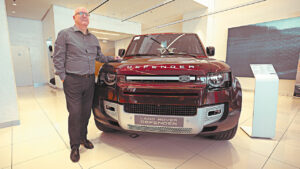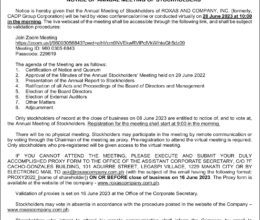The Velocity Q&A: Chris Ward (President Jaguar Land Rover Philippines)

Interview by Kap Maceda Aguila
RECENTLY, Coventry Motors Corp. (CMC), the local distributor of the Jaguar and Land Rover brands, quietly unveiled the all-new Land Rover Defender 130 to a select group of media and online content creators. Two examples (both already spoken for) of the largest iteration of the storied Defender were on display.
It’s said to be a “proper” eight-seater, with a body extended for the purpose — 13.4 inches longer than the 110. The Defender 130 is also available in an exclusive Sedona Red exterior color. Among other accoutrements, the 130 receives a large 11.4-inch display, a sliding panoramic roof, electronic air suspension, 14-way heated and cooled electric front seats with memory and four-way manual headrests, and 11.4-inch Pivi Pro infotainment system with Apple CarPlay and Android Auto. The HSE D300 variant gets 300ps and 650Nm on tap, and this diesel-sipping, three-liter V6 heart is mated to an eight-speed automatic transmission. The pricing of the new Defender starts at P11.89 million.
If you ask CMC President Chris Ward, more exciting days lie ahead for JLR. When he first assumed the post in 2019, he predicted, “Within three years, all the premium players will have a plug-in hybrid electric vehicle (PHEV) as a minimum because we have no choice. Whether it’s a little bit configured with a petrol engine or diesel engine for the majority, it will be commonplace. The premium market will adapt quicker than the volume market.” The intervening years have shown his vision to be accurate. Today’s local automotive scene is indeed well on the path of electrification, and JLR, along with other premium marques, is playing a significant role in pioneering the switch from pure ICE-powered vehicles to electrified ones.
We sit down with Mr. Ward and talk electric, the continued supply challenge, how the business is shaping up thus far, and what else is on the horizon for Jaguar and Land Rover.
VELOCITY: All Land Rover models will have electrified versions, is that correct?
CHRIS WARD: Globally by 2030.That’s still to be worked out. Some we may transition straightaway; there’s a couple of products that will, so the next generation will only be a full EV. We may delay switching off the production line of the outgoing model. Globally, we have 140-odd markets all in a different pace of transition. So, to do a hard cutoff might not work. But we still need to be transitioning. We will just look at when’s the optimum time to stop. But along the way, we’ll reduce the amount of options for engine availability and slim them down a bit as we go through this transition.
What are you seeing on the ground in the Philippines, in terms of our readiness for electrification?
Relatively speaking, it’s still early days. I think we’re still in the education phase, and the early adopters. The people that are coming over here the last 12 months… are those that perhaps have had overseas experience because they’ve been on holiday, they’ve hired an EV, they have business overseas. In that environment, they already understand (things like) range anxiety — and we’re seeing them come into the showroom more and more.
For our Jaguar I-Pace, we’ve doubled last year’s sales already, and I’ve got orders transitioning into next year. And that’s people coming to us — not necessarily (about us) force-feeding and spending huge amounts of money on marketing. This is kind of almost guerrilla; it’s about noises building up and they’re starting to come in. So, that’s really good. I think the governments are still getting their heads around exactly what they need to do — as I think is the case for construction and condo management companies, all the rest of it. They’re getting people knocking on the door. “Hey, I want to buy an electric car, you know. Where do I charge it?” So that’s the education bit that we have to keep pushing now… engaging with the government and all the various ancillary groups that have an important part, the electricity industry, all the legislative stuff, getting stuff through customs.
Would you agree with this statement: That the market, at least for premium brands such as Jaguar and Land Rover, is more ready or perhaps more willing to make that jump to electric?
I would say yes. I think we have the advantage because the infrastructure, the cost of producing these things, is massive. So at the premium end of the market, we can get a quicker return. (Much) of the mainstream (doesn’t yet have) the infrastructure. At the premium end, typically, people have their own home or they certainly have ease of being able to install a charger. They potentially have more than one car, and have more freedom of choice in what to do. So, the adoption into EV is much quicker.
I think we should as a brand represent what the future is about, and it is about sustainability. We’ve been talking about it for a long time. Jaguar Land Rover has a two-stage plan to go fully zero in terms of emissions by 2039. And that includes both the manufacturing and the dealer network — everything. Now that’s quite a target… (imagine) how many markets we trade in; how many dealers there are around the world. We want not only the production of the cars but the whole dealer network to be effectively carbon-neutral. That’s massive, but we’re on that journey.
To this day, everyone’s talking about an inadequacy in supply because of the global chip shortage, along with supply chain issues adversely affecting a lot of the lot of the brands. How is JLR doing in this regard? Of course, we know that JLR isn’t a volume seller compared to mass-market brands. Having said that, will you have units for people who want them?
Okay, for sure I don’t have any stock. The reality is I have more orders than I have cars. That’s creating, depending on the car line, anything up to a 15-month waiting list. But that is going to improve. You mentioned the semiconductor shortage, which is principally what’s driving that supply demand issue. We’re kind of now turning the corner, so for the next three quarters coming, my supply increases quarter-on-quarter by 20% to 30%. I would imagine that by second half of next year, we’ll be almost back to normal production. We can expect to supply demand reasonably, comfortably, by the second half of next year.
So that 15-month wait will be markedly shorter?
As we transition, yeah. I would expect that to come down to more like six to eight months max. That gives the clients exactly the color and trim that they want — the car in the production line is exactly the car that they ordered, not something that we’ve previously ordered that we then match to what they want… We brought in cars exactly how they want and we will match that moving forward. It’s taught us a lot going through the COVID experience. The factory can be more flexible and so we will turn down volume a little bit where it’s needed if there’s a lower level of interest. Where there is a high level of interest, we’ll turn it up a bit, but we’re still making sure that we’re building purely what customers want, not for stock.
Early on in the pandemic, it was actually the luxury market that had an uptick in business for various reasons — such as people were realizing savings because they couldn’t travel. We heard they went out and bought luxury cars. What have you observed?
Well, you’re absolutely right. We had an influx of customers the second half of 2020 when people still couldn’t come to the showroom. Then when world started to open up from lockdown, we saw a strong level of sales for those first six to nine months after. That very quickly generated a shortage of stock. Then with the advent of the semiconductor shortage that kind of carried on. But to be honest, the market is recovering. We will be, as a Philippine market, we should be back to 2019 levels next year. It’ll be close; we’ll end 2022 with a similar number to the strongest prior year. And then 2023 — the prediction is well then look to go beyond where we were in 2019 pre-COVID. So it’s been a three-year, steady kind of improvement — just to get us back to where we were in 2019.
So it’s really a supply issue now — that there’s pretty much more demand than what could be reasonably supplied at the shortest possible time?
Yes. And people soon cottoned on which were the halo cars in a particular range. Obviously, the Defender is one and we were getting people coming in. It was almost like, “Here’s my check, I want to get on the list.” How often do you have that in our industry? It’s been a good problem to have. As an industry we need to capture that and try and continue that environment and not get back to this, “We’ve always got to be driven by volume” (mindset). Because volume, to be honest, creates difficult practices for the dealer network and also consumers because you’re not sure you’re getting a fair deal. Have you negotiated a big-enough discount?
If it’s a sensible trading arena where there’s one price for the car, it also creates a steady resale value market as well. So, in two or three years’ time, you’ve got this maturity of the market, and it’s settled down. You don’t have prices spiking, and most of the manufacturers, except for the premium level, are all going down that route. We want to stop doing stack-‘em-high deals. We’d rather stabilize the market, build a few less cars, sell them a little bit more profitably, but create a really good stable environment for the client.




